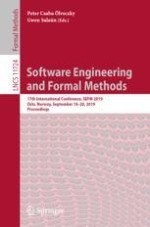This book constitutes the refereed proceedings of the 17th International Conference on Software Engineering and Formal Methods, SEFM 2019, held in Oslo, Norway, in September 2019.
The 27 full papers presented were carefully reviewed and selected from 89 submissions. The papers cover a large variety of topics, including testing, formal verification, program analysis, runtime verification, malware and attack detection,and software development and evolution and address a wide range of systems, such as cyber-physical systems, UAVs, autonomous robots, and feature-oriented and operating systems. They are organized in the following topical sections: cooperative asynchronous systems; cyber-physical systems; feature-oriented and versioned systems; model-based testing; model inference; ontologies and machine learning; operating systems; program analysis; relating models and implementations; runtime verification; security; and verification.
